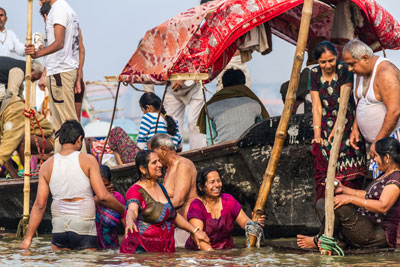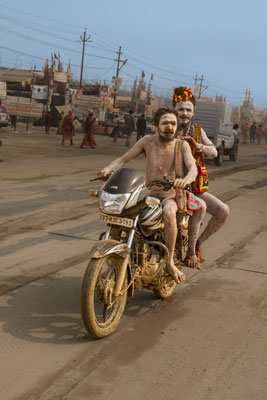Getting caught up in the spectacle of India’s Kumbh Mela festival
This article appears on page 20 of the August 2013 issue.
by Steve Emmet; Solana Beach, CA
As various sadhus (holy men) — with dreadlocks and beards, surrounded by humongous wreaths of exhaled marijuana and covered in ash but nothing else — raced their motorcycles up and down the mostly empty streets, I knew this had to be the Kumbh Mela.
Held every three years, the Kumbh Mela festival rotates among four different sites. It had been 12 years at the time of my visit since it had been held at the confluence of the Ganges, Yamuna and Saraswati rivers, the holiest of the four sites.
The festival
It is said that bathing in whichever river is the site of the Kumbh Mela will wash away your sins, so the festival is quite popular, with ever-increasing numbers of participants.
My wife, Yuki, and I opted to include the Kumbh Mela as part of a longer trip through India in April ’13. Our whole trip, including guides, transportation, hotels and tents, was arranged for the two of us by Banyan Tours (Delhi; phone +91 124 4563800).
After spending a few days in Varanasi (well worth visiting!), we drove 2½ hours to the Kumbh Mela, passing through many similar iterations of small towns, with cows, cow patties and tiny, fix-everything shops.
Our “super luxury tent” at the Lakshmi Kuthia Camp was mostly fabulous — huge, with a flushing toilet, hot water, munchies and a 4-poster bed with a hot-water bottle on each side and a modest heater nearby.
Dinner was all veggie and, with a variety of spices and flavors, somewhat tasty. We made friends with Aisha, who worked at the intake area, and she clued us in to a really good restaurant in the nearby town in case we got tired of the pure vegan fare.
In the background, down the hill near the river, it seemed there were 50 million people (actually, there were 500,000 on the days we were there) chanting, playing drums and burning incense and wood (not the best for my asthma). The folks at the tented encampment provided earplugs if guests needed them, but I, a New Yorker used to night sounds, liked it!
The chants of the 500,000 devotees (though there would be 19 million in a few days!) were amplified by electronic enhancement. Sanjeev, our excellent guide, said that this was the loudest festival he had experienced in all the times he’d been to the Kumbh Mela.
Tent city life
After a barely adequate breakfast (no eggs, of course, as it was purely vegan), we set out for a walking tour of the tent city that was set up next to the river. It was a photographer’s paradise! With extremely rare exceptions, people not only didn’t mind getting their photos taken, they either stopped so we could get a shot or even called us over, encouraging us.
Several gurus invited us into their tents, and in several tents there were performances of girls singing and dancing, depicting various elements of Hindu history. The costumes were really stunning, and we took a lot of pictures. Several of the gurus had foreign devotees, all seated and awaiting wisdom.
After lunch we went down to the Ganges, where but a few people were bathing, scrubbing their clothing and dishes and, of course, washing away their sins.
The Kumbh Mela grounds were actually quite well laid out and included latrines. There were police and fire engines present as a safety measure.
Each of the tent cities in the encampment had a number of sadhus who provided free food for one and all. Attendees brought their own stainless-steel lunch pails, and cooked food was placed on banana leaves, making it quite ecofriendly.
In general, the festival was a model of civic planning, planning which had its origins in a disaster at the 1954 Kumbh Mela, where a reported 500 people were trampled to death. Tragically, the powers that be did not extend this attention to detail to the nearby train station, the departure point for visitors returning to their home cities. Thirty-six people were fatally trampled there during the 2013 festival.
Getting around
Our tent was at the end of the water-distribution line, and we had no hot water the first night and only warm water the next night. Interestingly, our guide stayed in a less luxurious tent and had plenty of hot water.
After having several meals at the tent site (I’m clearly not cut out to be a vegan), we headed for Café El Chico in town, which Aisha had suggested. Dinner was superb! The restaurant had Indian, European and even American dishes and each was tasty. Dinner for five cost $60.
The next morning we headed for the area of the tent city where the Naga Sadhu holy men gathered. These ascetics are generally dressed only in their “sky dress” — covered with gray ash and, occasionally, a small modesty panel but nothing else.
Several sadhus invited us in to chitchat, and others, after a small donation, let us take their pictures, thanks to Sanjeev’s intercession.
After four hours or so we grew tired and, as our driver couldn’t find us, we took a tuk-tuk back. I discovered that, if you have a headache, traveling in one of these rather primitive 3-wheeled propane-powered vehicles is not ideal, as there are no springs and it is quite a jarring ride.
Various regulations interpreted differently by a number of police officials forced us to drive all around the Kumbh Mela campgrounds until we found one bridge we were allowed to cross to return to our tents.
The “photo ops” at this Kumbh Mela were absolutely superb! I am still working on the several thousand pictures that remain after eliminating the so-so images. Our 2-week trip cost us a total of $17,000, the “super luxury tents” priced at about $700 a night.
While not all of our guides nor hotels were excellent, Sanjeev was, indeed, superb and we recommend him highly.




